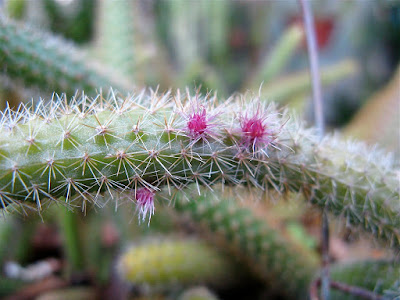Disocactus flagelliformis is endemic to Mexico, occurring in Hidalgo, Puebla and Veracruz, in areas with lots of fog above 2000 meters. It has a distribution following the cloud forest belt and can be patchily distributed within its range...
Disocactus flagelliformis also called as The rattail cactus, Cactus flagelliformis, Cereus flagelliformis, Cereus flagelliformis minor, Cereus flagriformis, Cereus leptophis, Cereus flagelliformis leptophis, Aporocactus flagelliformis, Aporocactus flagriformis, Aporocactus leptophis, Cereus minor, Aporocactus flagelliformis var. leptophils, Aporocactus flagelliformis var. pfeifferi, is a species of the genus Disocactus. This species was described by Barthlott in 1991.
IDENTIFY DISOCACTUS FLAGELLIFORMIS
Disocactus flagelliformis is endemic to Mexico, occurring in Hidalgo, Puebla and Veracruz, in areas with lots of fog above 2000 meters. It has a distribution following the cloud forest belt and can be patchily distributed within its range.
It is a cactus with hanging, light green, up to 1.5 m long and 2 cm thick stem, that has 8-12 ribs which are narrow, low, divided into wide, slightly protruding areoles. On the areolas there are bunches of brownish bristly spines, each about 3 mm length.
This cactus blooms in spring with fluorescent, tubular, raspberry-pink in color, about 5 cm long and 2.5 cm wide flowers. Outer tepals are linear-lanceolate, more or less curled, crimson, inner tepals narrow, elongated, crimson, sometimes with a pink tinge at the edges. Stamens white to light pink, erect, stigma of white pistil, with 5-7 lobes. It produces spherical, 10-12 mm long, 10 mm in diameter, red, bristle-covered, flesh yellowish fruits and ovoid, brownish-red in color seeds.
DISOCACTUS FLAGELLIFORMIS CARE AND CULTURE
Cultural information should only be used as a guide, and should be to be adapted to suit you. Your physical location; where you grow your plants, how much time you have to devote to their care, and many other factors, will need to be taken into account. Only then can you decide on the cultural methods that best suit you and your plants.
Light:
Disocactus flagelliformis prefers full sun. The basket with the plant should be hung on a sunny window.
Temperature:
During the active growth, this cactus is grown at room temperature. In winter, the plant needs a rest period at 7-10 ° C, although it can tolerate temperatures as high as 15-16 ° C.
Substrate, growing media and repotting:
Because of the dangling stems, this cactus is better to grow in hanging baskets. It is necessary to lay the basket from inside with sphagnum, and then fill it with soil mixture. If the cactus grows in a pot, then the pot must be hung or placed on a shelf. This species loves a rather fertile soil, the ideal composition is 2/3 of the soil mixture and one-third of the leaf humus.
Since this cactus rapidly grows, it must be repotted annually, preferably after the flowering period. The main reason for the repot is to give the plant a fresh soil mixture, as it quickly absorbs nutrients. If the roots of the cactus are completely covered with an earthen clod, then the plant should be repotted into a pot one size larger than the old one.
Watering:
In the period of active growth, watering should be abundant, the soil mixture should be well-moistened, but one should not allow the plant to stand in water. During the winter period of rest you should try not to allow complete drying of the soil.
Fertilizer:
During the whole vegetation season, every two weeks, you can spray cactus stems with a half-doze of liquid fertilizer.
Grow from seeds:
Cactus seedlings are very fragile on the first weeks and survival depends on how they are treated on that crucial stage; out of 100 of seeds in the wild only a few survive to an adult plant to produce seeds and start the cycle again. Obtaining a high percentage of adult plants from a batch of seedlings, depends on how each collector takes care of their seedlings.
Water for seedlings is the most important item to keep them growing for first few weeks. Generally, most seedlings, which are 1 week old will die after 3 days of dryness. 2 month-old seedlings can survive for 1 week if allowed to dry. 6 month-old seedlings can survive for 2 months if allowed to dry. 1 year-old seedlings can survive for 5 months if allowed to dry.
Planting instructions for 4”pot kit: First, clean with water and chlorine plastic pot, clear cover and label and wash with fresh water. Second, the soil can be sterilized for 2 hours at 120º C in an oven or a microwave but can be used without sterilization. Third, fill the pot with soil and spray with distilled, reverse osmosis or pure rainwater to let soil flatten at the top. Fourth, place to 1/8 to 1/4 inch layer of Dyna Rock or crushed sea shell extra fine on top to cover the soil making a layer between soil and seeds. Fifth, place seeds over the Dyna Rock and fine spray water the seeds well and cover with a clearcover.















COMMENTS